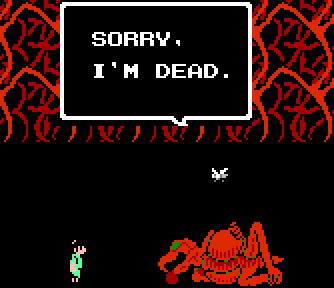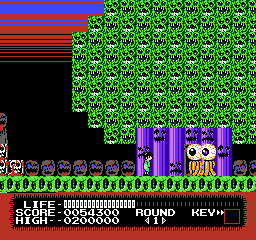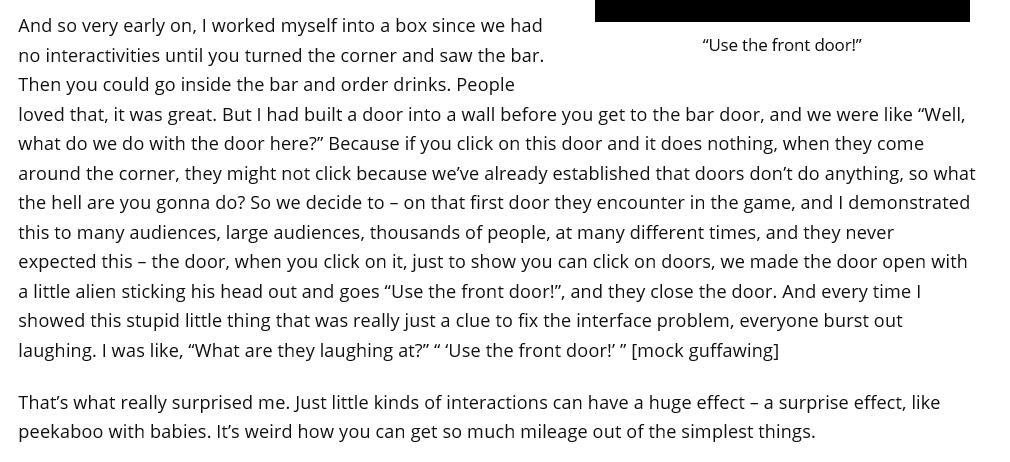 1. Firstly just a lot of little details to enjoy. We have the spider itself, a kind of alarmingly unreadable cartoon heap (called a “spider” here as that’s how the manual identifies it – but more probably a dead chicken or dinosaur, and when I encountered it I saw it as just a heap of rotting flesh). We have the sudden tonal shift in music and background that announces it, and builds up the curiosity of the encounter. And we have the text itself, which is a minor masterpiece of videogame writing: something which is simple and easy to read while still being extremely enigmatic as to anything it may actually imply. 2. I guess by “videogame writing” I mean both a formal and a historical quality. Firstly you have writing that has to adapt itself to the rhythms of an alien format. Vast swathes of the textual resources that prose has accumulated now have to be discarded. The specialised information demands of the format pushes writing back to that weirdly atavistic hierarchical state which modern writing has tried to erase (in the idea of that holistic writing where landscape description, point of view, minor gesture or utterance has as much weight and significance as a big dramatic speech) – here writing is not just split into the totally trivial, the vaguely-informative and the imperative, but it also kind of has to openly declare itself as such each time that it appears. Secondly you have the conditions that early international releases in particular had to go through: writing might have to be forced into a tiny textbox with a character limit, and then translated into another language by someone with only a very hazy grasp of what’s intended to be conveyed, and then compressed AGAIN into the same tiny textbox with the same character limit. And indeed sometimes rewritten entirely in localisation due to additional copyright or content requirements, etc. These elaborate restrictions might remind us of oulipo or surrealist writing but I think the texts themselves have an interesting difference. Surreal texts tend to privilege the noun, or noun-combination, the material fragment which emerges in rare and surprising ways. By contrast videogame writing tends to avoid any nouns or adjectives but the most commonplace - they tend towards convoluted directional assemblages, circling around some meaning that they cannot directly represent. Like being shouted instructions in a dark room. Language as sliding ice puzzle, with only the vaguest traces of any origin in human life: the “sorry” in “sorry, I’m dead” placed as ceremoniously on a doily on this aimless self-cancellation.  3. Another property in videogame writing, and videogames in general – discovering new affordances and then scrabbling to fill them up. The wandering NPC is a great modular tool, it can help pace locations, convey information, offset or enhance a mood, add to the sense of being in a place, help convey that an area is lively… but also, the usefulness of the generic NPC becomes a vague terror when it comes to the specific NPC – after placing these things around now you suddenly have to come up with individual chunks of text for them all! Text is both a resource and a drain, and I think part of the history of text in videogames is that of designers coming up with ways to plug this black hole. It was a while yet before technological and economic affordance would allow the generic NPC to become that settled repository for dolorously “naturalistic” polished lore sentences that we know and begrudgingly tolerate from AAA and indie alike today – “Howdy stranger. What can I get’cha? Rare to see new faces in this town. It hasn’t been the same since the war –now that all the youngsters left there’s nobody to maintain our previously buoyant fishing industry. This damn war… Well, sorry for flying off the handle there. If you’ve got any [squirrel hide], I’d be willing to trade for ‘em” and on and on and on forever. This kind of stolid, researched and dutifully ‘characterised’ Quality Prose turns out to be perfect filler for the indeterminate non-spaces of the videogame text system, and we are once again reminded that the Iowa Writer’s Workshop was not the least of the CIA’s crimes against humanity. But there was a point beforehand where videogame text almost had its own period of primitive accumulation – pulling abruptly and at random from the stacks of text around it, trying to find anything that would fill this new chasm. The NES Superman game is a particular favourite compendium of brilliantly inane videogame text. You can almost reconstruct the thought here: Superman lives in a city, Superman rescues people, we can populate Superman’s town with flavour NPCs, but what do they say? Well, that part is actually not that important to the Superman fantasy, so maybe they just say whatever: “Let me read your newspaper!” “…………..!?” “Palace disco is my favourite”.  Monster Party embraces a collage ethos both in subject matter (picking higgledy-piggledy from famous monsters past and future), in visual style (those totally abstract heaps of bloody, grinning heads, melding together in ways that make them hard to reduce to standard videogame ‘blocks’), and also in text. The text recited by Monster Party bosses is a kind of non-sequitor mangle of advertisement text, commercial fad signifiers, pop culture reference threatening command and just totally detached, aimless filler goofiness. (Nilson Carroll describes it: “The jokes are never good, nor are they ‘so bad they’re good,’ they just exist for the sole purpose of there to be jokes in the game, humor at its most abstracted.“) It uses the modular regularity of the videogame structure (level, boss, boss text, level block, etc) as an occasion to go scavenging for things to throw into that machine, to see how much affective damage the structure can take. But in doing so – it also ‘works’, in a weird way, the text registers and makes an impact which is surprisingly memorable and immediate, and also surprisingly funny. Why is that? 4. I think it’s interesting to use comedy as a lens for videogames because it involves timing, and timing is in part an awareness of how the brain assimilates material – it’s a window into the piecemeal, lurching work of consciousness as it sorts through the world. We might say that puzzles or simulations let us model cognition but these are forms which, as it were, give the brain time to set up shop: where it’s encouraged to take as long as you want, slowly internalizing the limitations, ideology and guiding assumptions of the host culture, slowly reconstructing consciousness with what’s to hand. Whereas a joke needs to work instantaneously - ideally it’s something we get before we realise there’s anything TO get, something ambushing consciousness as it travels back and forth on the perpetual rhythm between subject and object. I often think about the below anecdote about famous OG CD-ROM game, “Spaceship Warlock”:  The description of the crowd's reaction to this goofy placeholder joke stuck with me since I read it. Something is happening, something is making an effect, but it's happening in a way which almost precedes any kind of value formation around the supposedly awesome power of cdrom or puzzle solving or whatever. The laughter here is almost that of an instant, ticklish reflex – we’re startled without quite realizing why, the game has poked us in what turns out to be a sensitive location. 5. I think that playing videogames can resemble dropping pebbles down a well. Input, response, input, response… you drop something into the black expanse of the screen, it swallows your action whole, there’s a tiny flickering moment of uncertainty and anticipation, and then the splash comes back. Of course part of the appeal of the personal computer is that now the range of potential outcomes has been excitingly expanded: there might be a splash, or no splash, or a pause and then a splash, or it might cause somebody to climb out of the well and beat you up. The type of hard repeatable causal relationship that we, ideally, expect from basic mechanical actions is kind of up for grabs. You might do the same thing multiple times, but depending on what's going on in the computer it could have different results, with only the vaguest external prompting as to why. Any comprehensible causal chain has to be elaborately faked with 'good design', and even then it isn't completely exempt from the kind of mechanical failure which is too granular to anticipate or understand. Drop the pebble down the well and it freezes and hangs there and you have to take out and blow on the cartridge. There’s a pleasure which is also fear – these things offer an expanded field of capabilities in some way but those capabilities are also virtual and unreal, they can only be made to feel real by giving them a constant procession of invented obstacles to knock against. The real uncertainty of engaging with the digital black box is kind of deferred into smaller and more manageable uncertainties: can I make this jump, can I get past the boss. But the background uncertainty is still felt, it can only be temporarily assuaged over and over. Hence the kind of structural monotony of playing videogames, the sense that we’ve been doing the same thing over and over and not doing anything new – the same ritual of confirmation, testing the game only for it to obligingly respond and tell us that YES the buttons still do what they did every other time you pushed them. Yes I’m still here, yes I’m still here, yes I’m still here.. NO, I’M NOT HERE. The audience laughs and is also discomfited, partly by the sudden tonal shift, but mostly because we’d forgotten we were still asking the question.  6. The Spaceship Warlock joke and the Monster Party joke are like knock-knock jokes in reverse. In a knock-knock joke the guest is a mystery who resists identification: linguistic inquiry is revealed as a circular system of misdirection that tells us nothing about who’s actually beyond the door. In a reverse knock-knock joke, a different ritual of discovery is undercut – we open the door, and what’s behind turns out to be just as opaque and mysterious as the door was, we go past the surface and find another surface. Peekaboo is this kind of joke, playing with the child’s uncertain grasp of object permanence. But in videogames there IS no object permanence – videogames really are the Berkeleyan universe in which sensory perception is only granted the illusion of moment to moment coherence by the continuous attention of God (or a NES) behind the scenes. Taken as a comic, for example, the boss comments in Monster Party would likely just read as MAD style throwaway non-jokes, which they kind of are. What gives them bite is that they’re not declarations but responses, replies to the probing intelligence of the player – to a probing that the player may not have realized that they were engaged in. I’m reminded of Walter Benjamin’s description of aura as the way that an object seems to “look back at us”. In Monster Party we look down into the well and find somebody staring back up – peekaboo, I see you! Watch me dance! Look out baby, here I come. 7. Monster Party has stuck with me since I played it, the humour and goofiness and relaxed appropriation of cut-up techniques for use upon an unsuspecting commercial format. But I think parts of it also have a real power – that the approaches they used and the comedy they went for allowed them to dig under the skin of videogames, to tap into some of the subterranean rhythms that really animate the format, despite official disavowal that those rhythms exist. The pursuit of glee took them further than more illustrious or consciously ambitious competitors, as a reminder that if you’re interested in something, it’s worth not taking it seriously. Thank you giant spider, or as your friends call you, DEAD.  image credits: monster party pictures taken from nilsoncarroll.wordpress.com. the picture of kemco superman quotes found on i-mockery but there are many more out there... Back |